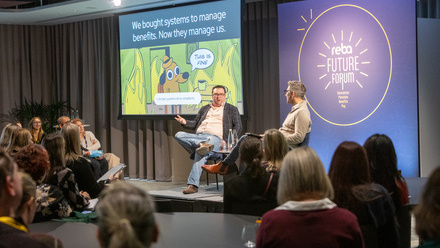Selecting the right benefits platform: Lessons learned
I talk to companies looking for a new employee benefits platform and get the chance to understand their current and future needs alongside their existing challenges and frustrations.
These companies range from those looking to implement an employee benefits platform for the first time to those who have had a platform for many years.
For those with an existing platform, a common set of patterns and themes emerge, highlighting issues and frustrations that should have been identified through their vendor selection process.
I’ve seen the pitfalls of vendor selection processes – lengthy RFPs that miss the mark, and answers from vendors that bend the truth and don’t hold up under scrutiny.
Let’s examine some actionable insights.
Challenge 1: Data on demand
The problem: Your data is key to understanding your people and improving your employee proposition. Your benefits platform should be a data powerhouse, but some platforms act like a digital Fort Knox.
With some platforms you’re stuck raising manual service requests, waiting days or weeks for essential data. Sometimes a provider may even charge a fee for the privilege.
Example RFP question: What capabilities exist in your platform for building, customising, running, and scheduling reports without external assistance?
Evidence required: You should be looking for the ability to run reports on demand yourself to address a variety of use cases (HR data, provider reporting, payroll reports). Can you create custom reports effortlessly? Can you adapt as your HR landscape evolves? Your platform should empower you to access your data whenever you need it and in a format that works for you.
Challenge 2: Handling complexity
The problem: With a myriad of financial, healthcare, and lifestyle options, each with its own set of intricate rules, the task can be daunting. Many HR platforms simplify benefits to mere ledger entries, failing to capture the nuanced choices employees must make. This often leaves companies mired in spreadsheets, struggling to manage complex entitlements and selections off-platform.
This is where employee benefit platforms step in. These fall into three broad categories, each with their own pros and cons.
- Spreadsheet dependant platforms. Some benefits platforms still rely heavily on external spreadsheets. You may inform the platform about each employee’s eligibility and entitlements, but the real complexity is still handled off-platform. Employees can make selections, but administrative overhead remains high due to intricate rules managed in spreadsheets. These platforms often struggle with other advanced selection rules, leaving some tasks to be handled outside the system. Unfortunately, buyers may overlook these limitations during vendor selection.
- Manually coded platforms. Certain platforms can handle complex scheme rules, but at a cost. They achieve this by writing custom code to reflect your business logic. While this approach provides flexibility, it comes with implementation and maintenance challenges. Consultants must translate requirements to developers, risking errors and delays. Even minor changes to benefit schemes become costly and time-consuming. These platforms are often considered legacy systems.
- Codeless benefit platforms. Platforms like Zest take a different approach. They anticipate complexity from the outset and use a codeless benefit builder. This allows you to configure every aspect of complexity without writing a single line of code. Consultants can implement and update benefits swiftly, bypassing the need for developer involvement. Scheme rule changes are easily reflected within individual benefits, creating a rich historical data trail. This approach automates administrative tasks while ensuring employees receive personalised options based on employee data that’s held in an HR platform.
RFP question: Explain how you configure a complex benefit [life assurance policy that includes free cover limits, step rules, funding and selection overrides for specific eligibility groups and where selection options are reliant on the selection of a related benefit] (use an example that reflects the most complex benefit you have)? Explain how your platform provides support for the changing of scheme rules over time within the context of a single benefit?
Evidence required: Ask your potential benefit platform provider to configure your most complex benefit while you watch. It should only take 15-30 minutes and it’s the best assurance you can get that they are able to handle your scheme complexity. You’ll get a really good understanding for how easy it is for them or you to change any your scheme rules as they evolve over time.
Challenge 3: A trust crisis in data accuracy
The problem: There’s nothing worse than being unable to trust the data that you receive from your benefits platform.
Imagine the repercussions if an employee is mistakenly left without life insurance coverage or access to medical care due to flawed data.
HR teams end up painstakingly combing through and double checking reports, negating any anticipated efficiency gains.
The root cause of erroneous data can be multifaceted. However, the risk escalates when reporting involves manual analysis, calculations, and transformations performed off-platform.
Companies may initially accept the need to pay additional fees for a fully managed service where reporting is performed manually. Yet, when errors surface, the concern quickly becomes paramount.
Platforms that struggle with scheme complexity often necessitate manual intervention in data enrolment or report generation, leading to inevitable inaccuracies.
Platforms that manage complexity using bespoke code are susceptible to errors, and issues made within code that is unique to a single client implementation can be difficult and time consuming to identify and resolve.
While no platform is infallible, when a defect arises within a codeless platform it will affect all clients equally, making them quicker to identify and resolve for the benefit of all clients.
Example RFP question: Does your platform require any manual intervention for data analysis, calculations, or transformations within reports? Please detail any manual processes involved in each benefit or payroll cycle.
Evidence required: Insist on a comprehensive demonstration of the platform’s reporting capabilities. Understanding the backend operations is as crucial as the user interface, even where you opt for a fully managed service. Witnessing the platform’s functionality first-hand is key to ensuring service delivery reliability.
Challenge 4: Stale content - lacking self-sufficiency
The problem: Many organisations find their platform content outdated and lacklustre, failing to showcase the constant evolution of their employee offerings, such as people policies, wellbeing initiatives, social clubs, and charitable endeavours.
This oversight represents a significant missed opportunity to present a comprehensive view of what it’s like to work for the company.
The root of the problem often lies in the limitations of their benefits platform, which either doesn’t allow for easy content updates or requires costly services from the platform provider for every change or new campaign.
It’s essential that companies are able to autonomously craft personalised and targeted content and communications. For instance, supporting a roadshow event with customised emails and highlighted content for a particular employee group should be straightforward and efficient.
Dependence on a platform provider for every update can lead to frustration and a stale employee experience as content becomes static due to the costs and management overhead involved.
RFP question: Could you detail the platform’s capabilities for enabling us to independently create and target content and communications without external support?
Evidence required: Ask your platform provider to show you the process of creating new pages and content within your portal, as well as setting up a targeted campaign, to ensure that you’ll be able to perform these tasks with ease.
Challenge 5: Unlocking automation
When implementing an employee benefits platform, companies have dual objectives: to better attract, retain, and engage talent, and to reduce the administrative burden associated with managing benefit schemes.
The latter goal can be achieved either by outsourcing administration or by leveraging technology for automation.
Administrative tasks encompass a wide range of activities, including creating and sharing provider reports, assessing eligibility, maintaining beneficiaries, handling underwriting requests, updating payroll, managing employee details and life events, sending communications, analysing scheme uptake and costs and identifying opportunities for improvement.
As your benefit offerings expand, so does the volume of administration.
While outsourcing remains a valid – if often costly – option, many of these administrative tasks are inherently rule-based and well-suited for automation.
Effective automation not only reduces costs but also minimises delays and potential errors compared to manual or outsourced processes.
Leading employee benefits platforms excel in automating these activities and more.
Despite the promise of automation, some companies find themselves still handling significant portions of administrative work. Two key reasons contribute to this:
- Limited configuration and customisation: Some platforms lack the flexibility to align with existing or desired business processes. Basic automation features may fall short, especially when dealing with complex scheme rules.
- Lack of self-service tools: Companies may engage with their platform provider infrequently. Without self-service capabilities, making changes to automated processes becomes cumbersome, and the fear of additional work and costs can keep companies wedded to the status quo.
RFP question: Could you explain how the platform automates the following administrative activities: [insert specific tasks that consume significant time and effort for your team]?
Evidence required: Ask the platform provider to show you how you or they configure each automation. Assess the ease of updating these automations to adapt to your evolving business needs, considering any changes over the past year.
Challenge 6: Fragmented employee experience
The allure of an employee benefits platform lies in its ability to amalgamate a diverse array of products and services into a single user-friendly employee experience.
However, the reality for many companies is a disjointed assortment of platforms, including discount programs, rewards systems, and various wellbeing apps.
This fragmentation can dilute the intended seamless experience, leaving employees to navigate a maze of portals and apps.
A coherent platform strategy, whether it opts for a single vendor or a collection of best-in-class solutions, is crucial. The strategy should articulate a unified employee journey, rather than a piecemeal addition of individual platforms over time.
A robust employee benefits platform should facilitate the addition of new pages and content, and enable the execution of comprehensive communication campaigns. It should serve as a central narrative that encapsulates all facets of your employee proposition.
Moreover, it should offer seamless integration with third-party platforms through single sign-on (SSO) capabilities, sparing employees from multiple logins.
Challenges arise when the platform lacks support for SSO with certain services or when adding and managing content becomes a burdensome or expensive task. This can lead to a fragmented user experience and hinder the communication of each platform’s role within the larger employee proposition.
RFP question: How does the platform facilitate the explanation, promotion, and access of our [existing solution] platforms?
Evidence required: Request examples of content created within the platform that elucidates and promotes other employee platforms, and how direct authentication via SSO can be configured to eliminate the need for multiple logins for employees.
Challenge 7: Changes causing downtime
Legacy platforms often struggle with the dynamic nature of long-term benefits. These systems typically have hardcoded rules and content, leading to a loss of continuity when transitioning between scheme years.
The inflexibility can result in platforms being taken offline for updates – a significant concern when employees face access issues for extended periods.
Contemporary, cloud-native platforms treat benefit rules and content as configurable elements, separate from the core platform code. This separation allows for regular updates and enhancements without disrupting access to the platform. Frequent releases signal ongoing investment and commitment to the platform’s evolution.
Extended downtime to make changes to benefit scheme rules or update content is a critical warning sign. It suggests an outdated approach to platform management that can severely impact the employee experience.
RFP question: Will any changes to benefit configurations, platform content, or settings cause periods of unavailability for users?
Evidence required: Ask the platform provider to show how changes to benefit scheme rules are implemented. A modern platform should allow for such updates to be made swiftly, ideally immediately where it’s not been set to take effect on a future date. Additionally, seek feedback from existing clients about their experiences with platform updates and any associated downtime.
Challenge 8: Lacking innovation and evergreen mindset
For SaaS providers, such as Zest, an ‘evergreen’ approach to platform maintenance and enhancement is paramount. This philosophy ensures that platforms continuously evolve, staying abreast of regulatory changes and driving innovation.
Dedicated product and development teams drive continuous discovery, design, development and deployment of new capabilities and engage with their clients to identify enhancements and features that would provide the greatest value.
In contrast, platforms developed by professional services firms sometimes treat upgrades as finite projects.
Once these projects reach their end date, the platform’s evolution can stagnate, leaving users with outdated tools that no longer meet current standards or inspire new efficiencies.
RFP question: How does your platform ensure continuous maintenance, enhancement, and addition of new capabilities to comply with evolving regulations and foster ongoing innovation?
Evidence required: Seek a roadmap or documentation that outlines the provider’s commitment to continuous improvement. Additionally, ask for recent examples of how the platform has adapted to recent regulatory changes and introduced new features without the need for project-based upgrades. It’s a lot easier to talk about a future that never arrives than it is to point at real enhancements that have been delivered.
Conclusion: Focus on fundamentals
It’s clear that the challenges discussed are not about the dazzling ‘art of the possible’ but rather the core capabilities that form the bedrock of any robust benefits platform.
While the issues I’ve highlighted do not constitute an exhaustive list, they serve as a guide to help you navigate the complex terrain of vendor selection with greater confidence and discernment.
Delve deep into the workings of your potential platform; insist on comprehensive demonstrations of every feature.
Remember, a benefits platform is a significant investment in your people – ensure that it not only delivers an outstanding experience for your employees but also alleviates the administrative load on your team.
Supplied by REBA Associate Member, Zest
Zest is the next generation platform that’s reinventing the world of employee benefits.








